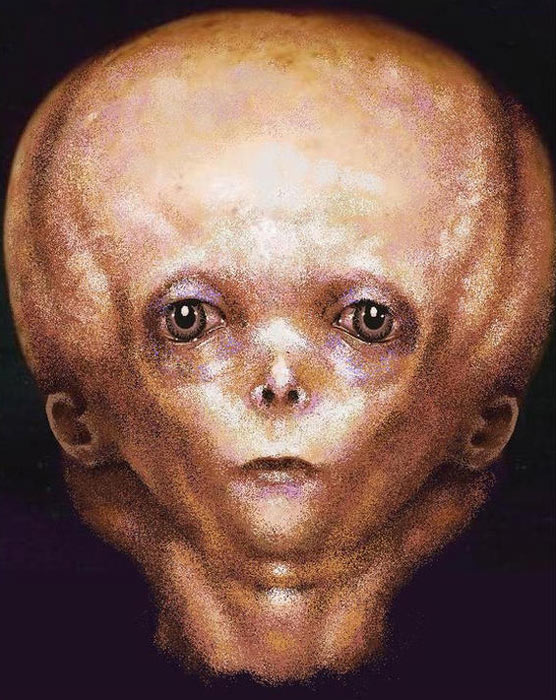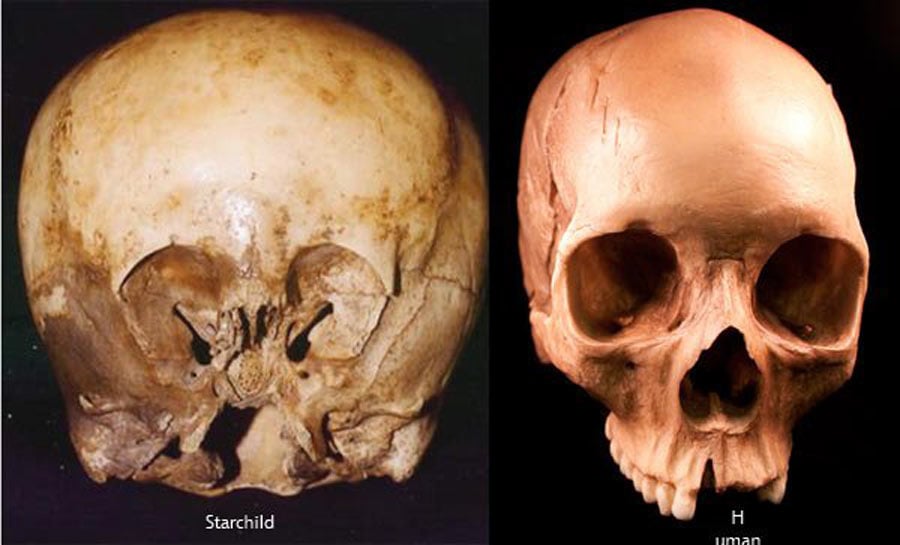Humanoid Skull Like No Other: Mainstream Rejection of Starchild Skull
It was back in the 1930s when an American teenager discovered an abandoned mine tunnel in Mexico’s Copper Canyon region. Inside it she found a human skeleton and, clutching onto its arm, was the hand bone of another skeleton buried mostly under the earth. It was described as being small and misshapen. The teenager returned to the site the following day only to find that a flash flood had washed most of the bones away. Nevertheless, the upper section of the skull of the buried skeleton, along with a small piece of the upper jaw bone remained. The significance of the so-called Starchild Skull remained unrealized for nearly 70 years.

The Starchild Skull was first discovered in Mexico. (Fair use)
Initial Research into the Starchild Skull
In 1999, the highly unusual skull, which has been dated at 900 years old, was handed to author and researcher Lloyd Pye to investigate after health professionals failed to identify a condition that could explain its appearance. The skull became known as the Starchild Skull, and between 1999 and 2013 Lloyd enlisted the help of numerous experts and independent medical and scientific institutions across three countries (USA, Canada, and the United Kingdom) to conduct extensive research and testing.
One of the major contributors to the research project was Dr. Ted Robinson, who had a background in medicine and plastic surgery and specialized knowledge of cranial surgery and cranial anatomy. Robinson studied the skull for a period of two years and involved specialists in the disciplines of radiology, ophthalmic surgery, oral surgery, craniofacial surgery, neurology and pediatric neurosurgery. The report Robinson prepared was astounding.
Firstly, Robinson’s expertise in cranial deformities enabled him to rule out all the human deformities he knew of that could account for the skull’s appearance. None of the other specialists were able to find any deformity, illness or cultural practice that could account for the misshapen head.
Secondly, Robinson reported that the bone of the skull is much thinner, lighter, and stronger than regular human bone. Analysis concluded that the Starchild Skull contains unusual reinforcing fibers, the brain is 30% larger than a normal human of its size, the frontal sinuses are absent, the eye sockets are shallow, and the entire skull has over 10 standard deviations from the human norm. This is a highly unusual statistic.

Artists depiction of how the child would have looked, after analysis of the Starchild Skull. (tonio48 / Deviant Art)
DNA Testing of the Starchild Skull
Robinson wrote: "One can only reasonably conclude from these statistical studies that the Starchild skull is distinctly different from human," wrote Robinson. Nevertheless, the medical reports and investigations were not enough to convince mainstream scientists that the Starchild Skull was definitely not human. Instead, they explained away the abnormalities with the claim that “nature can do anything.”
The scientists running the Starchild Project knew that the only definitive way of proving that the skull was not human was through DNA testing. So they waited nearly a decade while the technology for recovering and sequencing ancient DNA, such as the 900-year-old Starchild's, could be perfected.
In 2010, the Starchild Project secured access to a highly sophisticated DNA lab capable of recovering non-human DNA. Preliminary DNA testing found that a significant percentage of the DNA in the skull is not human. If verified, this finding would indicate that the skull belongs to a new species.
In 2012, a geneticist was able to secure a fragment of gene from the 5% of human nuclear DNA that code for proteins and which is a highly functional “master gene”, one of the most vitally important genes in the body of any species on Earth. It is known as the FOXP2 gene. Analysis was carried out on this gene, the full report of which can be read here, and the results were again startling.

Ribbon diagram of forkhead box P2 (FOXP2). (Swiss-Model / CC BY-SA 4.0)
Understanding the FOXP2 Master Gene
The FOXP2 gene in normal humans is 2,594 base pairs long and contains no variations. In mammals and other "higher" species, any single flaw in FOXP2, any isolated mutation or variation, can cause a severe negative impact in some of the most important aspects of development and will normally lead to death.
While a tiny amount of survivable mutations are possible in FOXP2, every one that occurs presents debilitating or life-threatening consequences, so up to this point in time none have been passed on to the general population of humans. This means in the vast, vast majority of humans, the FOXP2 master gene is absolutely identical.
The fragment of gene that was recovered from the skull and analyzed is 211 base pairs long (out of 2,594 base pairs). Now comes the incredible result of the analysis. While all normal humans have the exact same base pairs, the Starchild’s gene contained a total of 56 variations within the fragment! To understand the significance, in a rhesus monkey only 2 of its 211 base pairs would contain variation from humans. If it were a mouse, it would be 20. If a dog, 27.
- Bizarre Alien-Like Skull Unearthed in Korea was Naturally Formed
- The Ancient History of UFOs and the Oppenheimer-Einstein Report
To put this in perspective, let's imagine that when alive, the Starchild was indeed some unknown humanoid. No matter how different from humans it might have been, to be in the humanoid family its FOXP2 gene would have to be in the range of 1 or 2, or at most 3, base pair variations from a normal human. To go past 5 or 10 would put it into another class of species. To have 56 is to put it in another realm, another dimension entirely. It is utterly unique.
These amazing findings are the result of only a partial analysis of the DNA from the Starchild Skull. In 2013 the Starchild Project was registered as a company in order to raise the necessary funds to undertake a complete DNA test, which will determine once and for all the true nature of this most unusual species.

Illustration of an alien extraterrestrial. (Sasa Kadrijevic / Adobe Stock)
Mainstream Rejection of Lloyd Pye and his Starchild Skull
According to the HuffPost, in a 2013 article about Lloyd Pye and his work related to the Starchild Skull, “it takes some cojones to take a stand on the existence of aliens.” Nevertheless, mainstream science continues to argue that the skull belongs to that of a human child with congenital hydrocephalus, fobbing off alien arguments as pseudoscience.
“Lloyd Pye spoke often of the bias and fear that is built into the culture of mainstream science and academia, and it is probably that same sentiment that prompts skeptics to jump in with a negative opinion on the Starchild Skull before they have all the facts,” explains the Starchild Project website. Dealing with these subjects automatically attracts criticism, but members of the project call for us to listen to their scientific explanations keeping an open mind.
Top image: Starchild Skull vs average human skull. Source: Fair use
By April Holloway




















Comments
No reason to believe they haven’t happened upon a new humanoid species or even an alien. Future DNA analysis will hopefully answer the questions.
From stardust I was born, to stardust I shall return
fight your Aliens battles elsewhere; in fact, go find yourselves some face-huggers or headcrabs.
Sirius
What makes you think this Star child is a baby with a birth defect? The way they describe the sinus cavities and the shallow Eye pockets and as you look at the front, is very narrow and small area which will allow space for facial features. along with The enlarged head and brain area seems to indicate far more then Genetic defects in a human face.
The comments regarding genetic sequencing and the disparities between the species and correlation with humans is quite fascinating as well, which when interconnected with the physical findings seem to indicate something far beyond our current scope as we understand the human anatomy and DNA sequencing today.
There is an explanation for this. This is the skull of a Nephilim. They are written about in the bible. Google the name "L.A. Marzulli". He has done extensive research on this.
http://www.starchildproject.com/the-project/skullbasics
provides some info Wikipedia believes is insignificant. Their ignorance knows no bounds.
Pages